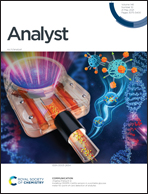Controllable generation of ZnO/ZnCo2O4 arising from bimetal–organic frameworks for electrochemical detection of naphthol isomers†
Abstract
The development of a rapid and low concentration detection method for naphthol isomers is of great significance for protecting human health and environmental safety due to their high toxicity and strong corrosivity. Here, we reported a novel hollow ZnO/ZnCo2O4 material derived by adjusting the molar ratio of Zn/Co of bimetal–organic frameworks (BMOFs) and its application for simultaneous detection of 1-naphthol (1-NAP) and 2-naphthol (2-NAP) by electrochemical methods. The oxidation peak currents of 1-NAP and 2-NAP on a ZnO/ZnCo2O4 modified carbon paste electrode (ZnO/ZnCo2O4/CPE) depended linearly on their concentrations in the range of 0.4–50 μM and 0.06–40 μM with detection limits of 0.13 and 0.02 μM, respectively. Their electrooxidation at the ZnO/ZnCo2O4/CPE was a one-electron and one-proton process. These excellent performances could be driven by the high conductivity and number of active sites as well as the unique structure of ZnO/ZnCo2O4. The tactic may shed light on developing new electrodes for fast and efficient electrochemical detection of naphthol isomers.



 Please wait while we load your content...
Please wait while we load your content...